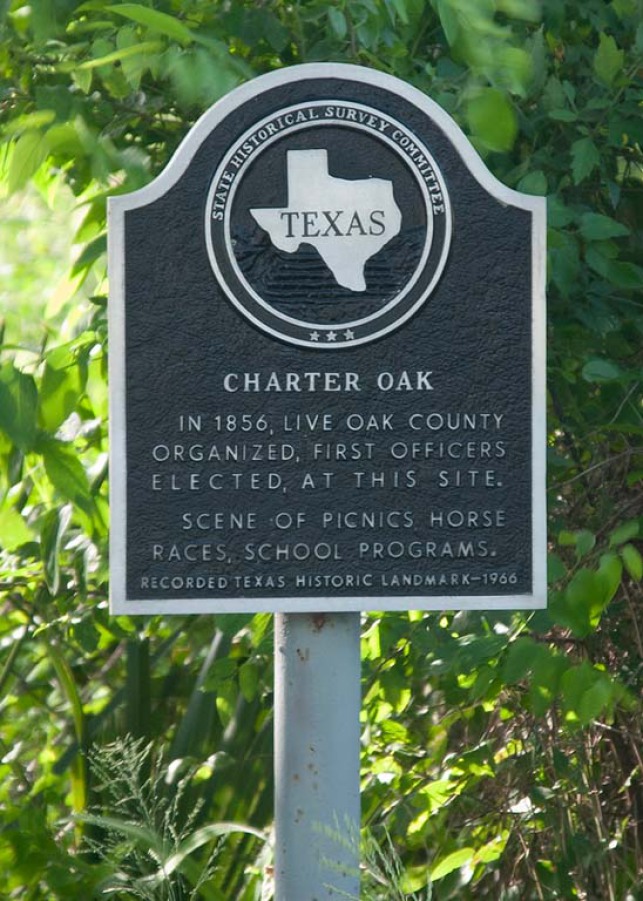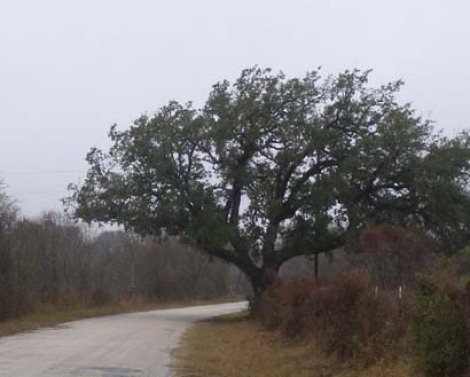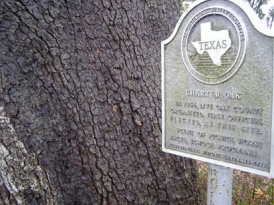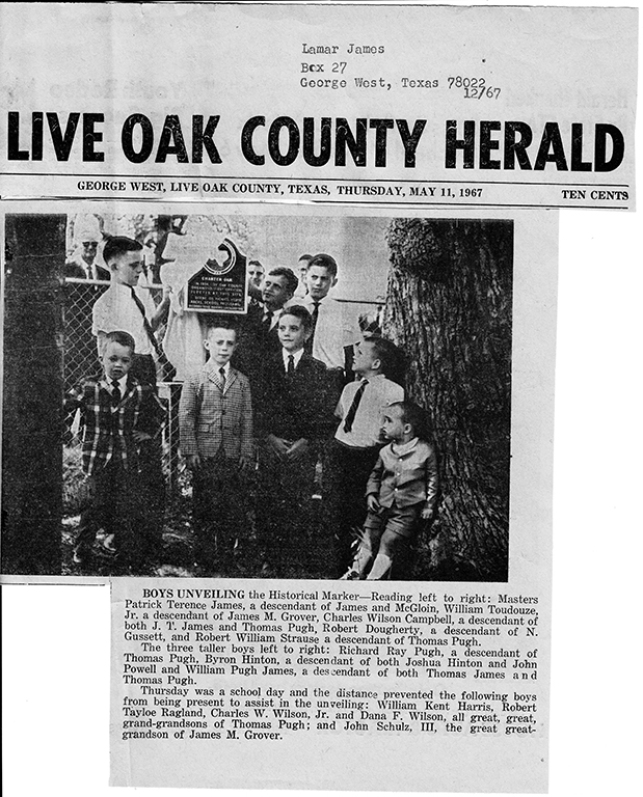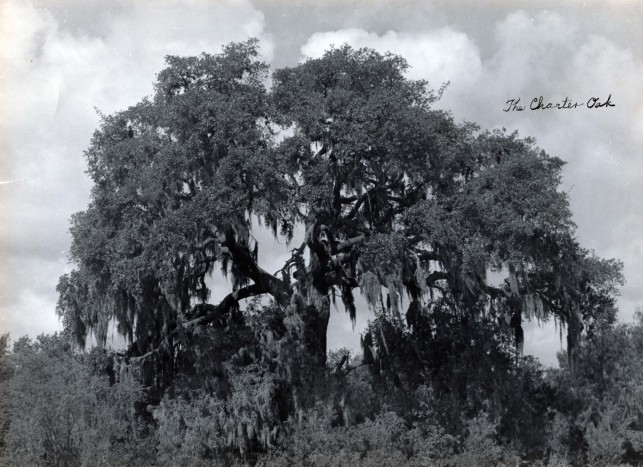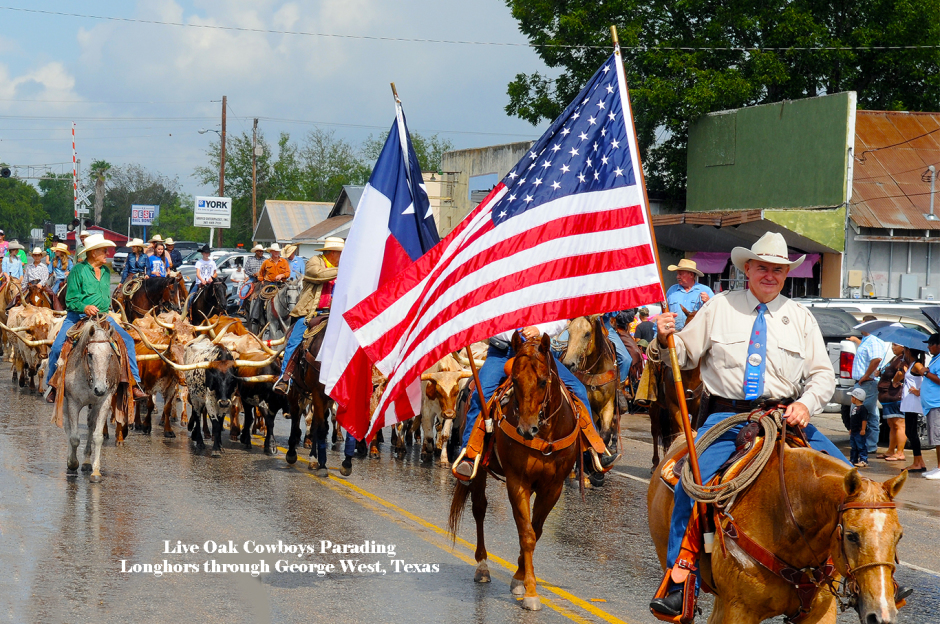
Charter Oak
Texas Historical Marker standing beside the Charter Oak on County Road 799 near Gussettville, Texas. Inscription reads, "In 1854, Live Oak County organized first officers elected at this site. Scene of picnics, horse races, school programs." Photo from Texas Historical Commission Archives. Read below photo of the original Charter Tree from Thelma Pugh Lindholm about actual events.
Charter Oak History
Narrative on the Charter Oak.
[No record of note has been found regarding narrative application. The THC Archive has none in the folder. Since this marker is one of the earliest markers, the narrative may well be recovered in another folder or none may have been required. However, notes from various writers appear here on this webpage for the benefit of posterity. The most informative is from Thelma Pugh Lindholm below her photo of the original Charter Oak, possibly taken by one of her grandparents.]
Live Oak County Judge: Honorable Harry L. Hinton
Live Oak County Historical Commission and Marker Chair: S.T. Brown, Jr.
Charter Oak Sponsor: ST and Charlie Brown
Narratives Below by Ervin Sparkman and Thelma Lindholm
Date Unveiled: 1966
Charter Oak Recorded Texas Historic Landmark Text:
In 1856, Live Oak County organized, first officers elected, at this site. Scene of picnics, horse races, school programs. (1966) Marker is Property of the State of Texas.
From Ervin Sparkman, The People's History of Live Oak County, Texas, Mesquite, Ide House.1981. 21-22:
The citizens in the northern part of San Patricio County tired of making the long, dangerous trip to the county seat of San Patricio to attend to legal business. After a meeting under a huge live oak tree [now called the Charter Oak] in Gussettville, the following men petitioned the Legislature to create a new county: Wm S. Gamble, G.W. Hargrave, John Powell, J.T. James, Henderson Waller, J.W. Mayes, D.R. Reid, John G. King, I.C. Barfield, A.P. Baker, James B. Lewis, Nat Kivilin, J.G. Kildey, Walter Merriman, Joshua Hinton, S.M. McNeil, Joseph Bartlett, H. Batman, George W. Wright, D.L. Wood, N. Gussett, James M. Grover, Thomas A. James, D.D. Robertson, J.B. Ammons, and T. Wilborn.
On February 2, 1856, the Texas Legislature approved an act creating Live Oak County, and the hot issue of that spring and summer was the selection of a county seat.
From Thelma Pugh Lindholm, The History of the People of Live Oak County, Texas. Self published by the LOCHC. 1982. 7.
Many historic events occurred at this old oak tree [Charter Oak], including a voting session of the county people in considering whether to secede from the Union in 1861.
In her 1950 master's thesis on the history of Oakville, Thelma Pugh Lindholm posted a full page spread of the original Charter Oak. The original, though located not far from the one above, is said to finally have been destroyed by lightning. It appears the younger tree nearby immediately became the icon and the tree for future gatherings; many argue its authenticity. The tree currently shading the marker too may pass. History is older than one tree or generations of people. Below is the photo and narrative of the original Charter Oak in Lindholm's master's thesis.
Original Charter Oak in Thelma Lindholm's master's thesis written for her 1950 Master's of Arts at The Texas College of Arts and Industries, Kingsville, Texas, now Texas A&M, Kingsville. Lindholm's two linear feet of Live Oak History known as Pugh Family Collection with hard copy at the Texas A&M, Kingsville Archives in Jernigan Library are also digitally available. (Note Thelma's beautiful handwriting on the photo. Photo courtesy Peggy Hillje.)
This narrative courtesy Thelma's niece, Peggy Hillje, who maintains a family collection, and Richard Hudson who Peggy invited to digitally archive information while he was working on a book about the history of Live Oak County. To see originals of either the photo or thesis use Pugh Family link above.
Lindholm's History of the Charter Oak
[From Thelma Pugh Lindholm, "Mother of Live Oak County History", while the central body of information below is from Lindholm's thesis, she updated parts post master's for the county's centennial, the Charter Oak marker, and the LOCHC County History Book.]
"Before taking up the History of the Live Oak tree on the east side of the Nueces River only a short distance up the River from the Shannon Crossing,
there are a few explanations that should be made: there is a small Record Book, size 8 X 12 inches, the cover is gone, the pages are of unruled blue linen paper, and unnumbered. Some of the pages are
in bad condition from water and paper mold. The writing on the damaged pages is legible.
It is in this book that some "first" meetings were recorded. References to this book will be, Original Record Book (n.p.) County Clerk's
Office, Live Oak County.
There are two other books, they are both marked Marriage Record Books, the one having the earlier dates has no cover, most of the pages are
loose from the binding, the pages are hand numbered; the other book is in good condition and is marked, Record of Marriage License, No. B.
These two books have a few recordings of interest and importance that do not come under the heading of Marriage Records but do tell of meetings that
were held in the shade of the Live Oak Tree.
Empresarios John McMullen and James McGloin received their empresarlo contract on August 17, 1828 to settle: east of the Nueces River. They arrived
with the first thirty-six families on December 16, 1829. The headquarters of this colony was at the Villa de San Patricio de las Nueces, now known as San Patricio. (1) James Power, a compatriot of
McMullen and McGloin, brought settlers here who were direct from Ireland, and it was some of these emigrants who settled on the east side of the Nueces River in the vacinity of the Live Oak Tree.
(2)
_____________
1. Map compiled by Stephen F. Austin, published by Tanner, 1838, File 128, State Library, Austin, Texas.
2. Ships Passenger List, Monsignor Oberste' s Library. Refugio, Texas.
________________________________________________________________________
Twenty-one years later these Settlers found the trip to the county capital, San Patricio, long, tiring, and dangerous. (3)
The following men are listed as having met under the Live Oak to discuss separating from San Patricio County: Wm. S. Gambel, G. W. Hargrave, John Powell,* J. T. James ,* Henderson Waller, J. W. Mayes, D.R. Reid, John D. King, I.C. Barfield, Thomas Pugh,* A. P. Baker,* James B. Lewis,* Nat Kivilin, J. C. Gilday, Walter Merriman, Joshua Hinton,* S. M. McNeil, Joseph Bartlett,* H. Batman, George W. Wright,* D. L. Wood, N. Gussett, James M. Grover,* Thomas A. James,* D. D. Robertson,* J. D. Ammon, and T. Wilborn. (4)
After some discussion these men selected the name, Live Oak for their county, if granted by the Legislature. (5)
Whether the above men sent a petition of request or selected a committee from their group to represent them before the Texas Legislature the records
do not show, but the Legislature passed an Act creating Live Oak County, on February 2, 1856.
"The same Legislative Act creating the county appointed commissioners to organize the county, John Powell, George W. Wright, Wm. Gambel, Henderson
Waller, D.L. Wood, N. Gussett, James B. Lewis, and James M. Grover." (6)
These men met on August 18th, 1856 under the boughs of the same Live Oak tree where they had held their previous meeting. It was a convenient place,
only a short distance from the Shannon Crossing on the Nueces River. Some of these men lived on the west side of the River. It was only a slingshot distance from N. Gussett's store. (7)
___________
3. Binkley, William C., Official Correspondence of the Texas Revolution, 1835-1836, Vol. 1, 626. The "List of Mail Routes and Roads." From Fox's Settlement to San Patricio, 45 miles. It was
not the distance in miles, but the condition of the road that made the great distance.
4. Asterisk marked have known descendants living in Live Oak County at present, 1966.
5. Original Record Book (n.p.) County Clerk's Office, Live Oak County.
6. Ibid.
7. Location of place by description on report. Tree accepted by all.
_______________________________________________________________________
At an election held in Live Oak County on the (obliterated [date]) of August, A.D. 1856, the following officers were elected, to-wit: Chief Justice,
John Powell; (8) W. Mayes, Sheriff; S. McNeill, District Clerk; A.P. Baker, County Clerk; Walter Merriman, County Assessor; and Nathan Kivilin, County Treasurer. (9)
This election was held under the Live Oak Tree. The county's Capital location had not been decided on. N. Gussett argued it should be Gussettville.
John Powell thought on the Sulphur would be better. Powell had been appointed Chairman of the Committee to organize Live Oak County. Powell would not concede to N. Gussett to hold the election in his
store - so it was held under the Live Oak Tree. (10)
The Oak Tree, by now, had reached an historical significance; it had an active part in the early school activities also.
The first settlers of Fox's Nation, later Gussettville, arrived from Ireland in l834. Rev. Henry Doyle's name is on the Albion passenger
list, Rev. T.J. Mallow's is on New Packet's passenger list. These very early priests taught secular subjects. They taught the children in family groups, but on special occasions the families
met for an all day "get-together". They met under the Historical Live Oak. (11)
Early on Tuesday morning, July 5th, 1875, the public school was closing its ten months session conducted by Mr. Wm. Cassin. A fine platform and seats for about three hundred
people had been erected under the cool shade of a huge Live Oak, whose mossy limbs formed a gorgeous canopy over the rural scene. A table nearly eighty feet long was visible - a foreteller of the
good time coming.
_______________
8. Chief Justice Powell was from a settlement known as "on the Sulphur". Later Oakville, the County Capital.
9. Original Record Book (np) County Clerk's Office, Live Oak County.
10. Ibid. The argument recorded in detail. The Oak Tree was on neutral grounds.
11. Children of Thomas and Margaret Pugh attended these schools. Rev. Mallow used the Pugh home to teach in. Family Bible, The Thelma Pugh Lildholm's Library.
_______________________________________________________________________
While the savory smell of meat in the process of barbecuing was scented, the children, under the direction of County Judge G.H. Jones, commenced their
exercises ... some twenty declamations and dissertations were given before dinner. The program continued after dinner and was closed by Judge Jones.
Judge Jones reminded his audience that there were five wagons loaded with melons on the grounds. After refreshments the large audience then dispersed
to their homes, deeming it the largest gathering they had ever seen and the happiest day they had ever spent in Live Oak County. (12)
Texas seceded from the Union by the action of the secession convention, January 28, 1861, and ratified by the people the 28th of February,
1861.
Chief Justice Gambel called a special election, five voting places were designated.
Oakville Pleasant Hill Gussettville Echo Lagarto
No. 1 No. 2 No. 3 No. 4 No. 5
For Secession 71 30 10 14 16
Against Secession 1 0 1 7 0
A controversy occurred again, this time between N. Gussett and James B.
Lewis, each contended his home was the logical place to hold the election. A compromise was reached by setting up a table under the Historical Live Oak Tree. (13)
________________________
12. Taken from an article written for the Corpus Christi Weekly Gazette, July 24, 1875. It began: Gussettville, July 17, 1875. Believing that you take pride in encouraging the efforts of the youth of
the country, I send you the following for publication: program in detail. Signed : A Visitor. Original paper in Thelma Pugh Lindholm's Library.
13. Marriage Record Book, No. B. Live Oak County, George West, Texas. County Clerk's Office, pp. 40-45.
________________________________________________________________________
Following this election a Mass Meeting was held in Oakville on the 4th of July, 1861. One hundred and twenty men signed an "Oath of Allegiance to The State of Texas and to the Confederate States of Amerlca", of these men fifty-three of them have known descendants living in Live Oak County at present, 1966. (14)
Gussettville, as did other parts of the county, suffered from the drought in 1869. Cattle had to be driven miles to the Nueces River for water; the
stock were in such weak condition and after drinking their fill they could not climb the river bank; there they died. It was during this time Mrs. Bridgett McGloin, a widow, skinned enough animals
that from the sale of the hides she paid for 160 acres of land. Land was selling for about 50¢ an acre. Mrs. McGloin acquired the land on which the Historical Live Oak was growing.
J.G. James inherited the above acreage from his Grandmother, Mrs. Bridgett McGloin. He said the ground around the Historical Live Oak was often
called, "Bulls' Graveyard". As time and places changed underbrush was thick under and around the Oak Tree. Range Bulls grew old, stayed near the Nueces River and just seemed to hibernate and die in
the brush there. Over a period of time more than thirty bulls were known to have died there. (15)
Jesse Robinson is given the credit for having fired the shot which killed the gunner of Santa Anna's Canon in the Battle of San Jacinto. Mr. Robinson
was nearing 80 when the Texas Legislature voted bonuses to its Revolutionary patriots, wishing to receive his bonus "in person" he rode horseback from
________________________
14. Book marked Birth, Death, Marriage, pp. 76-78. County Clerk's Office Live Oak County, George West, Texas .
15. The late J.G. James told his story to his son Jim James, George West, Texas.
________________________________________________________________________
his home on the Ramirena Creek to Austin. Grandpa Robinson cashed his bond and brought his $600.00 home in gold.
Mr. Robinson is said to have stopped at the Thomas Pugh home, some seven miles up the Nueces River from the Historical Live Oak on his trip to and
from Austin. He is said to have crossed the Nueces at the Shannon Crossing camped for the night under the Historical Oak and ate the noon meal with the Pugh family. On his return he spent the night
with the Pughs and on reaching the Shannon crossing, which was just below the Historitcal Live Oak, the river was up and his horse tired. Mr. Robinson decided to again camp under the shelter of the
Live Oak before resuming his trip home. (16)
Joseph M. Gerhard moved from San Patricio in 1879 and bought land on the west side of the Nueces River from the Historical Live Oak.
During his mother's short illness, prior to her death, it was necessary for her to have some medicine , but because of floods, the Nueces River was on a rise, and it was impossible for anyone to cross over to Gussettville to get the medicine.
James B. Lewis is credited with this report. He and some other neighbors, up at the Store heard some "Help Calls". On arriving at the River, one of
the men climbed the Historical Oak Tree. He could hear Gerhard calling to them what to do. Old Bob, after much persuasion, by friends on the east side, swam the river. Old Bob was Mr. Gerhard's Hound
dog. Friends tied the medicine to Old Bob's collar then he returned to his master with the medicine.
_________________
16. Mrs. Ellen Pugh told this to her Grandaughter, Thelma Pugh Lindholm.
________________________________________________________________________
The Historical Live Oak has had part in the "lighter side" of Live Oak County's History.
John Crump was a cattle driver over the Kansas trail. Crump enjoyed a good joke, especially if it was at the expense of the other fellow. Crump was a close friend of the McGloin family. He had a "camp shack" under the Historical Live Oak. He had a pack of hounds which on one occasion had caught a fat bob cat. While Crump was cooking the cat in a stew for his dogs, Willie Pugh James, son-in-law of Mrs. McGloin, rode up and dismounted. James remarked, "Crump, you surely are cooking something that smells good". "A stew for the dogs," replied Crump. James commented he would like to sample it. "Just help yourself," was Crump's reply. After James had eaten and remarked on what good rabbit stew it was, Crump laughingly informed James it was bob cat stew. The victim swore he was sick. It took some fast talking on Crump's part to avert a mauling.
Mr. Crump is said to have been so swift on his feet that he won more races than any horse. On one occasion neighbors had gathered for a "Basket Picnic" under the Historical Live Oak. Crump saw a jack rabbit in Mrs. McGloin's open field. He bet some of the men he could catch the rabbit; the bet was accepted but lost, for Crump overtook the rabbit, kicked it over, and triumphantly picked it up. (17)
There was another occasion of an all day "Basket Picnic" in the shade of the Historical Oak Tree. Horse races and tournament contests were the amusements of the day. There were a few women who were good on horse back and were contestants in the events. Mrs. Gallagher, Aunt Pebby, as she was
_____________________
17. Minutes of Commissioner's Court, Book No. 3, pp. 227-580, County Clerk's Office, Live Oak County. The records show 75 men were paid bounties for killing cats, lobos, coyotes, and the first time Jack rabbits are mentioned they brought $1.00 a dozen. Crump's swiftness did pay off.
________________________________________________________________________
later known, was one of the best riders. On this occasion she was entering the tournament contest. Mrs. Ellen Pugh (widow of William Pugh), Mrs. Bat Pugh, Mrs. R.J. Dobie, Mrs. Freeman McWhorter and some other women were seated in chairs in the shade watching the contests. One of the women remarked that Pebby was just trying to show her agility. Pebby heard the remark and indignantly stated, "That's a lie. I have on a pair of Gallagher's drawers."
This [following] incident did not occur under the Historical Live Oak. Dances, at this period were held in the homes, but it was so near the Live Oak tree in Mrs. McGloin's home, it is worth writing.
The late E.W. McWhorter, who made the trail drive from Texas to Kansas and other railroad markets eighteen times, said that Gussettville was the place where the "Waltz" was introduced into Live Oak County. McWhorter said the new dance was first seen at the Willie Pugh James and Aggie McGloin wedding dance. The older women of the settlement were outraged, and condemned the "Waltz" as immoral.
________________________________________________________________________
Notes of Interest
Some names on page two are marked by an asterisk. Footnote 4 explains why they are marked. There are some other facts that are of interest about these men.
Live Oak County's County Judge, Harry L. Hinton is a great grandson of John Powell's. Judge Hinton is a grandson of Joshua Hinton, and his home is on the exact site of his grandfather's in Oakville. (1956)
J.T. James owned land adjoining Oakville and a number of his descendants have inherited his land and are living on it. (1982)
The James B. Lewis land is in the neighborhood of Gussettville, his heirs own and live on part of his land. His nephew, T.J. McCumber (deceased 1982), is Chief Justice of the Peace of Precinct No. 1 of Live Oak County now, 1966.
Thomas Pugh and his wife, Margaret, arrived from Ireland and during their six week stay in New York, Thomas Pugh got his "citizenship papers". They and their six children came on to their grant of land on the East side of the Nueces River some seven miles up the river from Gussettville. His great great grandson, William Dee Pugh (deceased) and family live at the original Thomas Pugh home site. The home Thomas's son, William, built is used as a guest house.
This item doesn't pertain to heirs living on ancestors' original land, but a beautiful document: James M. Grover was one of the eight men the Texas Legislature apppointed to organize Live Oak County, Mrs. Jackson Ormand of George West, has her Grandfather's two page, "11 Sec." Document form the Texas Legislature entitled:
Live Oak County
An Act to Create
the county of Live Oak, and
attach it to the Fourteenth
Judicial District
Approved Feb. 2nd, 1856.
________________________________________________________________________
The heirs of Joseph Bartlett still own a large acreage of his land which is located south and west of Oakville along the Nueces River.
Thomas A. James' grandsons and great grandchildren own and some of them live on his original grant.
Mrs. Bridgett McGloin was mentioned several times, her land is owned and lived on by her grand and great grandchildren. (One is my nephew, Jim James. T Lindholm)
Mr. Jesse Robinson's great granddaughters have homes and live on his land.
Joseph M. Gerhard's estate is owned and lived on by his grandchildren.
A part of Aunt Pebby Gallagher's land is owned by her great grandsons. They excell in tractor driving as she did in riding a horse.
Mr. E.W. McWhorter's ranch is owned by his daughter, Mrs. R.J. Toland.
Dr. G.P. Reagan was one of the 120 men who signed the "Oathe of Allegiance to the State of Texas and to the Confederate States of America," and one of the fifty-three having known descendants living in Live Oak County. Mentioned his father's profession, Dr. Charles, like his father, lived in Oakville and practiced medicine in Live Oak County.
Dr. G.P. Reagan's land is owned and lived on by the Reagans today. Dr. G.P. Reagan's great grandson, Robert Henry (Bob) Reagan is the Sheriff of Live Live Oak County now, 1966. (since deceased).
The "Notes" could go on and on but, and old saying comes to mind:
"Once one has wet his feet in
the water of the Nueces River,
he will return."
If you recheck the number of families whose ancestors were associated with the Charter Oak this saying might be paraphrased to read:
"Once one has stood on the
ground in the shade of the
Charter Oak, he will not
leave Live Oak County."
________________________________________________________________________
CONCLUSION
It is sincerely hoped that this paper has given a pictorial understanding of the historical significance of the Charter Live Oak Tree of Live Oak County and a sympathetic interest in the People whose lives were paralleled with its history.
This tree, from a small acorn grew to importance and fame as have many of the families it sheltered more than a hundred years ago." Thelma Lindholm.
